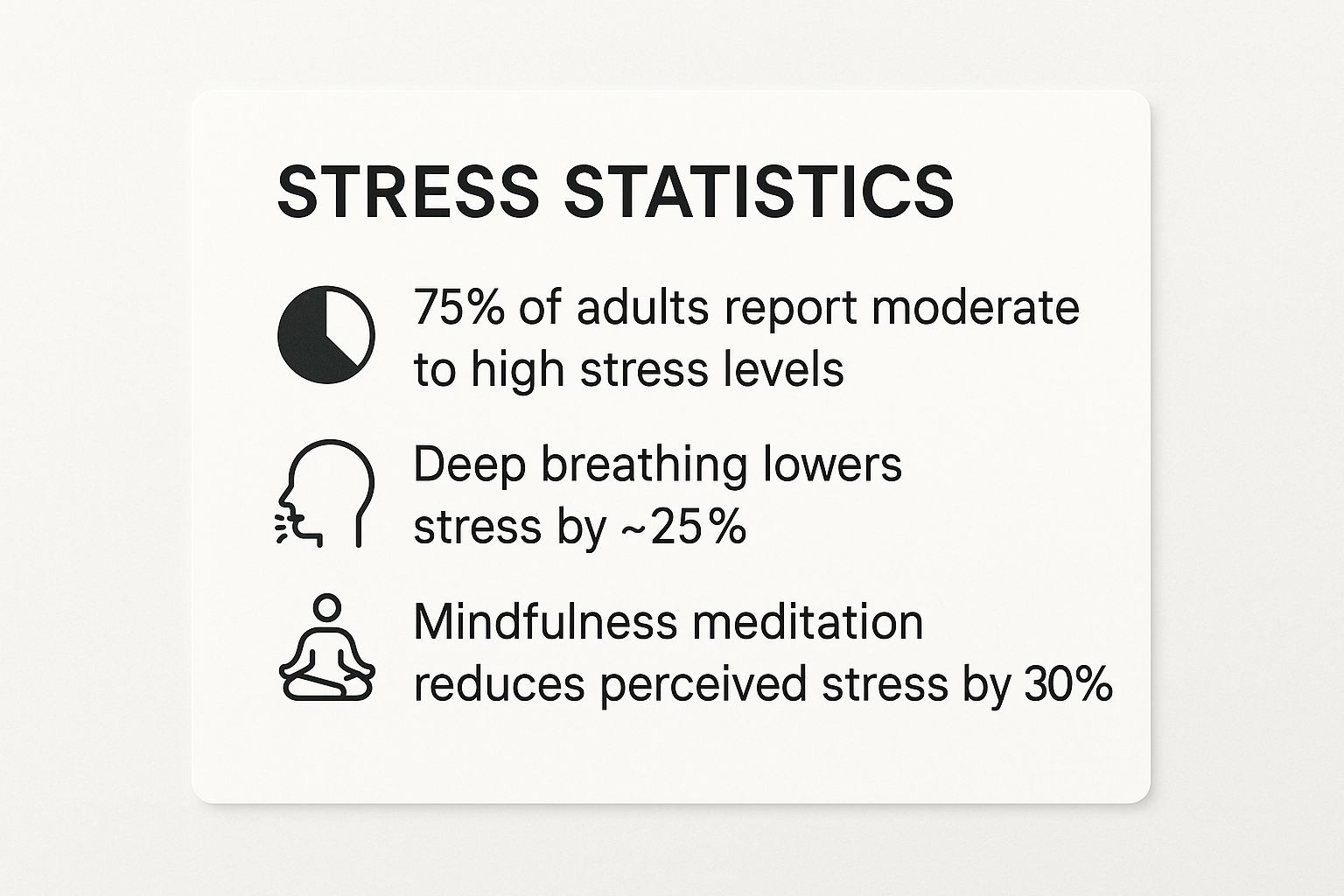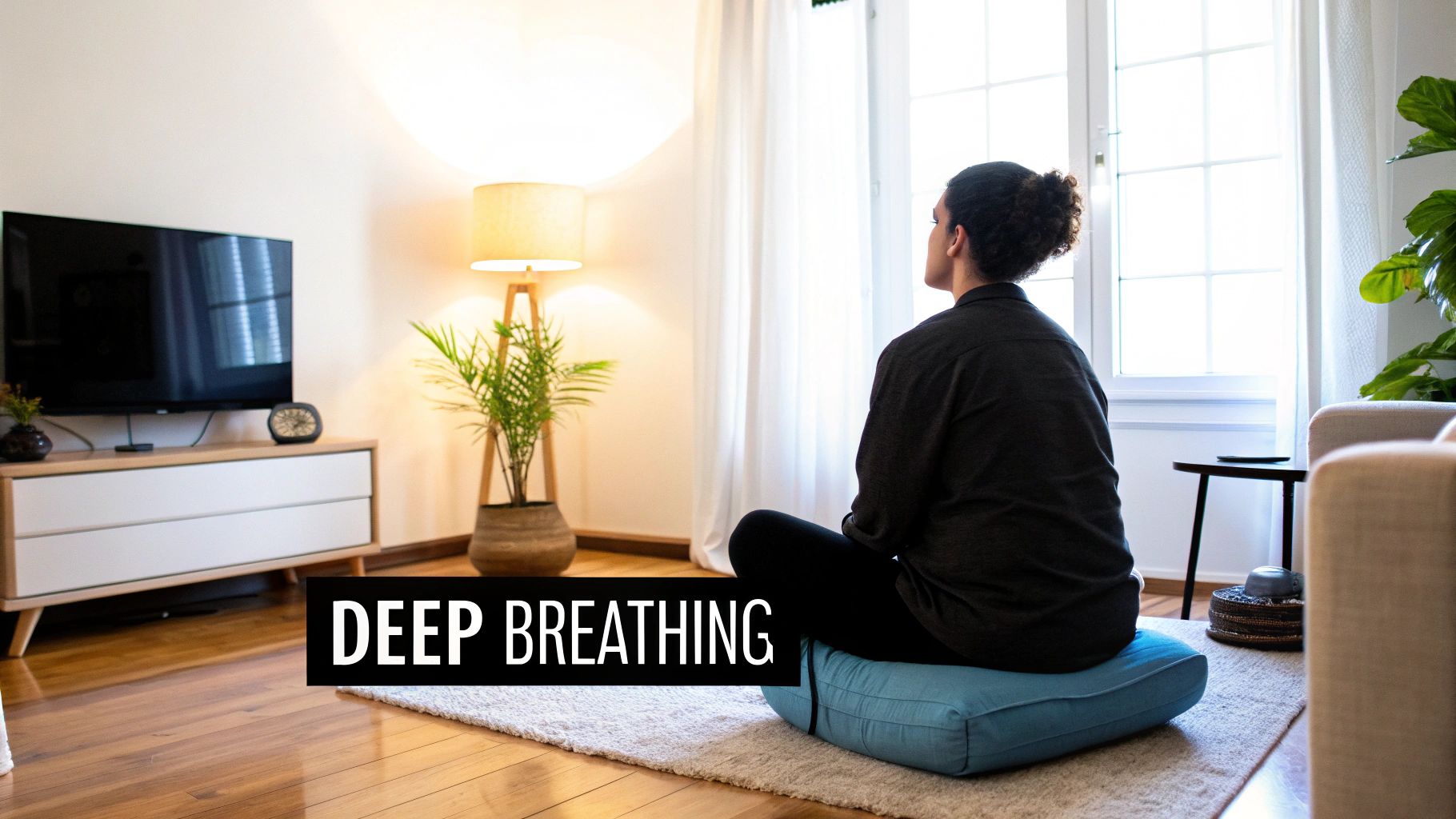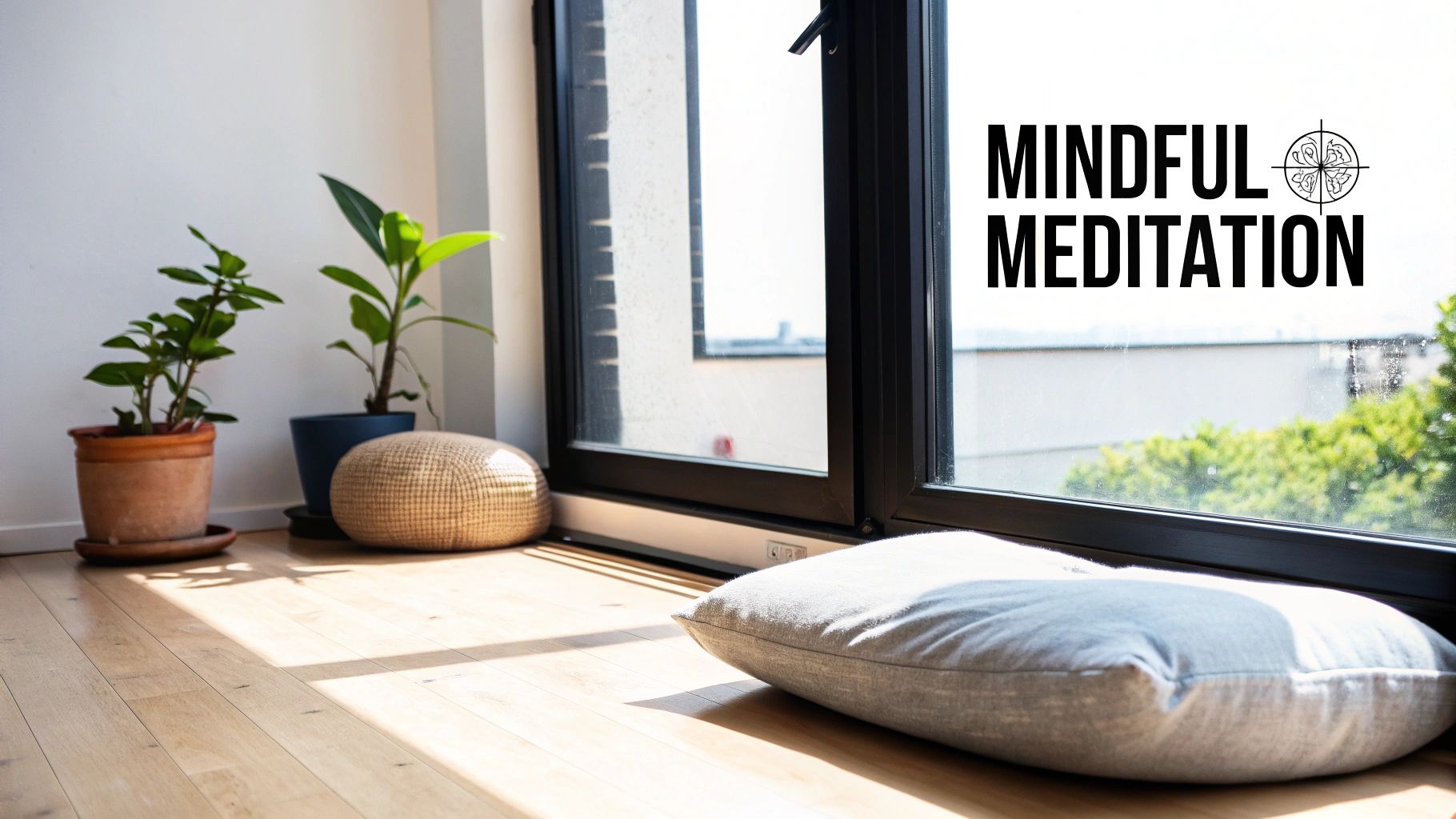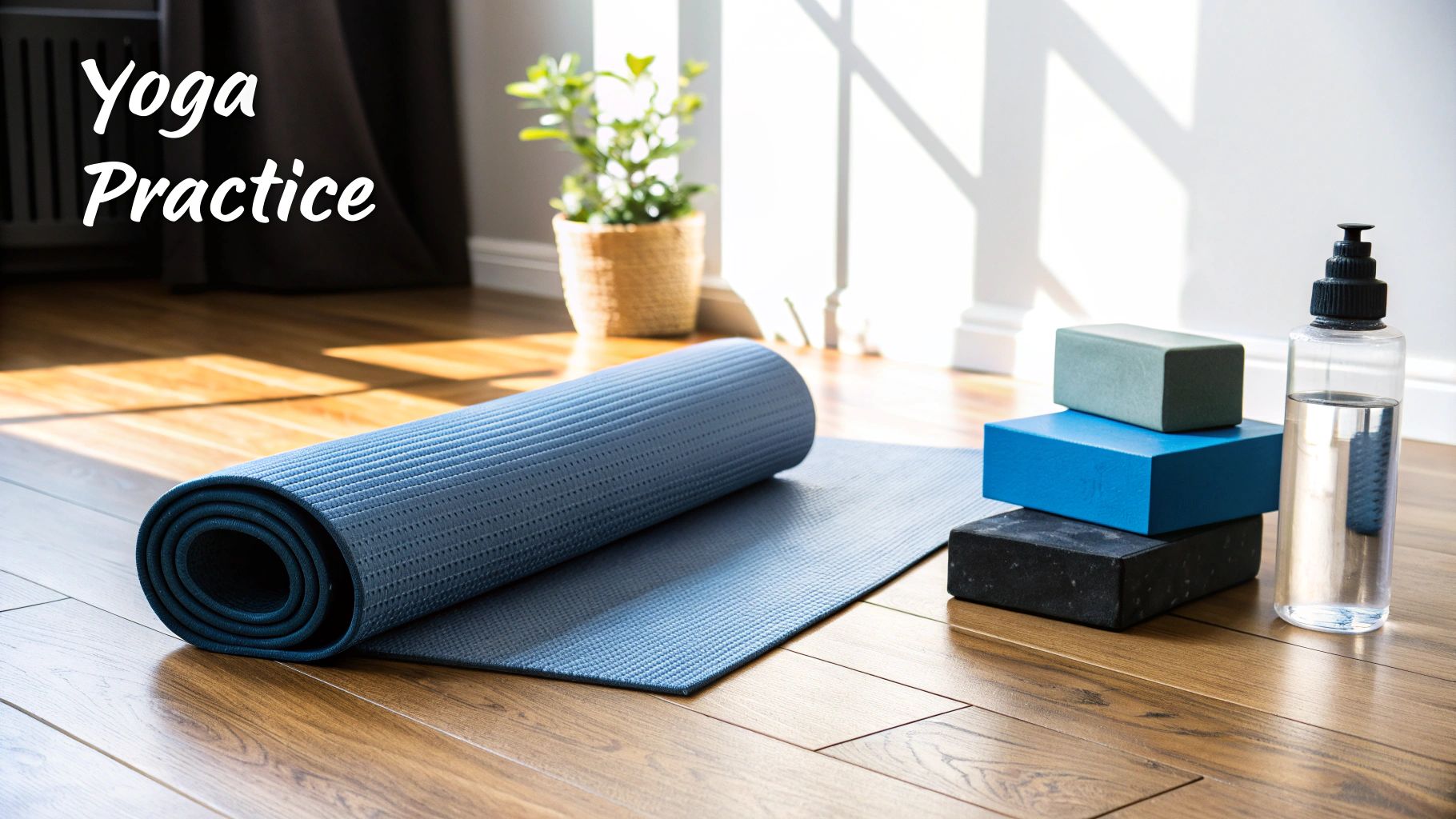When stress starts to feel like a constant companion, it’s easy to think you need a drastic life overhaul to find relief. But what if the path to calm isn't about grand gestures, but about small, quiet moments woven into your day?
It’s about focusing on four core pillars: mindful breathing, connecting with nature, gentle movement, and nourishing your body. These aren't complicated or expensive—they’re simple, effective ways to reclaim your peace, starting right now.
Your Starting Point for Natural Stress Reduction
Feeling overwhelmed is a shared human experience, not a personal failing. When the pressures of work, relationships, and daily life pile up, our bodies kick into a natural stress response. The secret to managing this isn’t to eliminate stress—that's an impossible ask—but to build a personal toolkit of simple practices that bring you back to centre.
You don’t need a week-long retreat or a complex programme. The most powerful methods are often the simplest, grounded in reconnecting with your body and the world just outside your door. It’s all about making small, intentional choices every day that add up, building a strong foundation of resilience against whatever life throws your way.
The Four Pillars of Natural Stress Relief
The journey to a calmer mind begins with foundational habits. Think of these not as another list of chores, but as acts of kindness to yourself. We can group these essential practices into four main categories:
- Mindful Breathing: Deliberately slowing your breath sends a direct, powerful signal to your nervous system that it’s time to relax.
- Nature Connection: Even just a few minutes spent outdoors can lower stress hormones and genuinely lift your mood.
- Gentle Movement: Simple activities like a short walk or a good stretch release pent-up physical tension and boost those feel-good endorphins.
- Body Nourishment: A balanced diet gives your brain the essential nutrients it needs to manage stress effectively.
This infographic gives a clear picture of just how common stress is, and the significant impact these simple, natural interventions can have.

The data speaks for itself. While most adults are dealing with significant stress, techniques like deep breathing and mindfulness can slash its perceived intensity by up to 30%.
By focusing on small, manageable steps, you empower yourself to take back control. You can learn more about turning these into lasting habits by exploring healthy coping mechanisms for stress in our detailed guide.
To help you decide where to begin, here's a simple breakdown of these four pillars and a first step you can take for each one—today.
Four Pillars of Natural Stress Reduction
| Technique | Primary Benefit | Your First Step Today |
|---|---|---|
| Mindful Breathing | Immediately calms the nervous system and lowers your heart rate. | Take five deep, slow breaths, focusing only on the sensation of air filling your lungs. |
| Connecting with Nature | Reduces cortisol (the primary stress hormone) and improves mood. | Step outside for 10 minutes without your phone and just observe what's around you. |
| Gentle Movement | Releases physical tension and boosts mood-lifting endorphins. | Go for a 15-minute gentle walk on your lunch break, noticing how your body moves. |
| Nourishing Your Body | Stabilises blood sugar and provides vital nutrients for brain health. | Swap one sugary snack for a handful of nuts or a piece of fruit. |
See? It doesn’t have to be complicated. Just pick one and give it a try.
The Power in Your Lungs: Mindful Breathing

When you're searching for natural ways to feel less stressed, the most powerful tool you have is already with you. It’s your own breath. It doesn't cost anything, and you don’t need special equipment or a quiet room. You can do it at your desk, stuck in traffic, or standing in a queue at the supermarket.
The idea is beautifully simple. By deliberately changing the pace and depth of your breath, you send a direct message to your nervous system: it’s time to calm down. This simple action helps shift your body out of that high-alert "fight or flight" state and into a more relaxed "rest and digest" mode. The result? A slower heart rate and a drop in stress hormones like cortisol.
Practical Breathing for Real-World Stress
Forget thinking of this as some formal, complicated meditation. These are practical tools for real life. Think of them as your first-aid kit for stressful moments, like when you need to ground yourself before a tricky conversation or quiet a racing mind so you can actually get some sleep.
Here are two incredibly effective techniques you can try right now:
- Box Breathing: This one is brilliant because it’s so easy to remember, even when you're feeling frazzled. Picture a square. Breathe in for a count of four, hold for four, breathe out for four, and hold again for four. That steady, predictable rhythm is incredibly grounding.
- The 4-7-8 Breath: This is a game-changer for anyone who struggles to switch off at night. Breathe in quietly through your nose for four seconds. Hold that breath for a count of seven. Then, exhale completely through your mouth for eight seconds, making a gentle whooshing sound.
The real magic isn’t just in the counting. It’s about paying attention to the feeling of the air moving in and out of your body. This focus yanks your awareness back to the present moment, breaking that endless loop of stressful thoughts.
These aren’t just quick fixes. When you practise them regularly, you're actually retraining how your body responds to stress. You’re building a foundation of calm you can come back to whenever you need it. For a few more exercises to add to your toolkit, check out our guide on breathing techniques for relaxation.
Weaving Mindful Pauses into a Hectic Day
Let’s be realistic—the goal isn't to add another chore to your never-ending to-do list. It's about finding tiny pockets of calm that already exist in your day. Think of them as "mindfulness moments," little pauses to reset and reconnect.
Here’s how you can actually make it happen:
- Link it to something you already do. Try taking five deep, slow breaths every time you sit down at your computer or just after you hang up the phone. Tacking a new habit onto an old one is the easiest way to make it stick.
- Use the in-between moments. The time you spend walking from the car to the office? Waiting for the kettle to boil? Perfect. Use those little gaps for a few rounds of box breathing.
- Set a simple reminder. It could be a quiet alarm on your phone or even a sticky note on your monitor. A simple prompt to pause and breathe in the morning, at lunchtime, and in the late afternoon can make a world of difference.
This approach turns breathing from a vague concept into something you can actually do. Every mindful breath is a small investment in your own wellbeing, slowly building a more balanced and resilient state of mind. It's one of the simplest and most effective answers to taking control of your stress, naturally.
The Restorative Effects of Connecting with Nature

When life feels like it's all a bit too much, one of the most potent remedies is waiting just outside your door. Connecting with nature isn’t just a nice distraction; it’s a proven way to actively lower stress, quieten a racing mind, and genuinely improve your mental wellbeing.
The great outdoors offers a simple, powerful antidote to the pressures of modern life. Time spent in green spaces—whether that’s a vast national park or a small city garden—triggers a real physiological response. It helps to lower your body's production of cortisol, the main stress hormone, while lifting your sense of calm. This isn't just a feeling; it's a measurable biological shift.
You don't need to plan a huge expedition to feel the difference. Small, regular doses of nature are incredibly effective. It’s all about making a conscious choice to step away from the screen and immerse yourself in the natural world, even for just a few minutes each day.
Making Nature Your Go-To Stress Reliever
Weaving nature into your routine is about finding what works for you and your surroundings. Here in the UK, we're surrounded by opportunities, from local parks and riverside paths to ancient woodlands. The trick is to start seeing these places as part of your personal stress-management toolkit.
A major UK survey backs this up. It found that 80% of Britons say being in nature directly makes them happier, while an incredible 74% reported feeling less stressed and anxious after spending time in a natural environment. These aren't just numbers; they show just how vital regular access to green space is for our mental health. You can discover more about how nature boosts UK wellbeing in the full report.
This connection doesn't require a dramatic lifestyle overhaul. It’s about small, deliberate actions that fit into the life you already have.
-
The Lunch Break Reset: Instead of eating at your desk, why not take your sandwich to a nearby park? A 20-minute walk can completely change the direction of your afternoon, clearing your head and shaking off mental fatigue.
-
Mindful Commuting: If you can, try walking or cycling part of your commute through a park or along a tree-lined street. Pay attention to the sights and sounds around you. It turns a routine journey into something truly restorative.
-
Weekend Woodland Walks: Explore your local woodlands. The Japanese practice of Shinrin-yoku, or 'forest bathing', is all about being calm and quiet amongst the trees, observing the nature around you while breathing deeply. It’s a powerful antidote to a stressful week.
Bringing the Outdoors In
Even when you can't get outside, you can still tap into nature’s calming influence. This is especially helpful on rainy days or for anyone with limited mobility. The goal is simply to create a sensory experience that echoes the peace of a natural setting.
Think of it as creating small sanctuaries of calm within your own home. By bringing elements of the natural world indoors, you provide your brain with gentle, restorative stimuli that help counteract the effects of stress.
Here’s how you can do it:
-
Surround Yourself with Plants: Houseplants don't just improve air quality; they have a proven calming effect. The simple act of caring for them can be a mindful activity in itself.
-
Use Natural Scents: Diffuse essential oils with earthy or floral scents like pine, lavender, or sandalwood. Our AuraFlow device offers a simple way to enjoy these aromas, creating a moment of calm with each breath.
-
Listen to Nature Sounds: Playing recordings of rain, birdsong, or a flowing river can significantly lower stress levels and help you either focus or relax.
By intentionally weaving these small practices into your life, you build a stronger, more resilient response to stress. Nature becomes a reliable partner on your journey to a calmer, more balanced state of mind.
Integrating Nature-Based Activities into Your Routine

A quick walk in the park is fantastic for hitting the reset button, but if you want to really amplify the stress-reducing power of nature, it’s about building a consistent connection. It's about shifting from the occasional visit to making the outdoors a core part of your wellbeing routine.
This changes your relationship with nature from something you just look at to something you actively participate in. When you become a participant, not just an observer, the mental health rewards go so much deeper.
The Power of Green Social Prescribing
Across the UK, a brilliant concept called 'green social prescribing' is really taking off. It’s where healthcare professionals are now referring people to non-clinical, nature-based programmes to support their mental health.
The idea is simple but incredibly effective. It acknowledges that organised activities—like community gardening, conservation projects, or outdoor mindfulness groups—give us both a vital link to nature and much-needed social support.
Recent research has shown that these structured programmes are remarkably good for mild to moderate mental health conditions, with real improvements often seen in as little as 12 weeks. A government-backed initiative even set up seven 'green social prescribing' sites in England, referring patients to things like horticultural therapy. You can read the full research about these nature-based interventions to see just how positive the impact is.
This isn’t just about getting a bit of fresh air. It’s about finding purpose, building a community, and getting a sense of accomplishment in a natural setting. It provides a supportive structure that can feel way more accessible than trying to motivate yourself to get outside alone, especially when you’re feeling low.
Finding Your Place in Nature
Getting involved is easier than you might think. Lots of local councils, charities, and community groups run programmes that are often free or low-cost.
Here are a few popular options that are gaining momentum in the UK:
- Horticultural Therapy: This is all about using gardening to boost mental and physical health. The simple, mindful tasks of planting, watering, and just tending to something alive can be incredibly grounding.
- Community Gardening: Joining a local allotment or community garden gives you a double win: gentle physical activity and social connection. There’s something special about working alongside others towards a shared goal.
- Conservation Volunteering: Groups like The Wildlife Trusts or the National Trust nearly always have local volunteer groups. You could be doing anything from footpath maintenance to habitat restoration, giving you a real sense of purpose and a direct, positive impact on your local area.
A quick search online for "community garden near me" or "conservation volunteering [your town]" is the best way to start. These groups are almost always looking for new people and are incredibly welcoming to beginners.
Start Small and Bring Nature Home
You don't need a massive garden or access to a sprawling forest to feel the benefits. The trick is to start with something small and manageable that fits right into your life as it is now.
Creating your own small-scale nature project can be just as powerful. Think about what you can realistically handle and what would bring you a small moment of joy each day. This way, your new habit feels like a treat, not another chore on the to-do list.
A Simple Window Box Herb Garden
- Choose Your Herbs: Start with something easy and hardy, like mint, rosemary, or basil. Their amazing scents are a wonderful sensory boost on their own.
- Find a Sunny Spot: Most herbs just need a good few hours of sunlight, making a kitchen windowsill the perfect spot.
- Mindful Tending: The daily ritual of checking and watering your plants is a perfect, built-in mindfulness moment. It pulls your focus into the present and away from whatever’s stressing you out.
This tiny act of nurturing something green in your own home is a powerful, daily reminder of our connection to the natural world. It’s a simple, real step you can take today to reduce stress naturally.
Lifestyle Tweaks for Lasting Calm
While quick-fix breathing exercises are fantastic for in-the-moment relief, building true, long-term resilience to stress happens in the small, consistent choices we make every single day.
Think of your daily habits around food, sleep, and movement as the very foundation of your mental wellbeing. Getting these right doesn’t mean a complete life overhaul. It's about making gentle, intentional adjustments that work for you.
When stress hits, it's so easy to reach for a sugary snack or another coffee for a quick boost. But we all know how that ends—the inevitable energy crash that leaves you feeling even worse. A more mindful approach to what you eat can make a huge difference in how your body and mind handle pressure.
Nourish Your Body to Settle Your Mind
The food on your plate directly fuels your brain and can either dial up or dial down your body's stress response. Simple swaps can have a surprisingly powerful stabilising effect.
For instance, trading a high-sugar biscuit for a handful of almonds gives you a dose of magnesium, a fantastic mineral known for helping to calm the nervous system.
Focusing on a balanced diet rich in the following can also help keep your mood on an even keel:
- Omega-3 Fatty Acids: Found in oily fish, walnuts, and flaxseeds, these healthy fats are brilliant for supporting brain function.
- Complex Carbohydrates: Foods like oats and whole grains provide a steady release of energy, which helps you sidestep the blood sugar spikes and dips that can make irritability worse.
- Plenty of Water: This one’s simple but crucial. Dehydration itself can increase cortisol (the stress hormone), so keeping your water bottle topped up is an easy win for your body.
Make Restorative Sleep a Priority
Sleep is non-negotiable. It’s when your body and mind get to work repairing and resetting from the day. The frustrating catch-22 is that chronic stress often ruins sleep, and poor sleep makes you far less resilient to stress.
Creating a calming bedtime routine is one of the best ways to break this vicious cycle. You need to signal to your body that it’s time to wind down.
About an hour before you want to sleep, try dimming the lights, putting all screens away, and doing something relaxing. This could be reading a book (a real one!), some gentle stretching, or taking a warm bath. Adding a few drops of calming scents can deepen this ritual; you can learn more about the benefits of using essential oils for relaxation to create a truly tranquil atmosphere.
A consistent sleep schedule—yes, even on weekends—is your secret weapon. It helps regulate your body's internal clock, making it much easier to fall asleep and wake up feeling genuinely refreshed and ready for whatever the day throws at you.
Embrace Gentle Movement
Ever notice how your shoulders feel tight and your jaw is clenched when you're stressed? Your muscles literally hold onto that tension. Regular physical activity is a brilliant way to release it.
You really don’t need gruelling, high-intensity workouts to feel the benefits. In fact, gentle, restorative movement can often be far more effective for chipping away at stress.
Activities like a brisk walk, a bit of yoga, or even a leisurely cycle all release mood-boosting endorphins and help to lower cortisol levels over time. The key here is consistency, not intensity. Aim for about 30 minutes of movement on most days. It’s not about pushing your limits—it’s about moving your body in a way that feels good, shaking off the physical residue of stress, and clearing your head.
Common Questions About Natural Stress Relief
Whenever you start building new habits, a few practical questions are bound to pop up. It’s completely normal.
Getting clear on these common queries can give you the confidence to really commit to reducing stress naturally, making sure you feel equipped for the journey ahead. Let's tackle some of the things you might be wondering about.
How Long Does It Take for These Methods to Work?
That’s the big question, isn't it? The good news is some techniques bring almost instant relief. A few slow, deep breaths can calm your racing heart and quiet your mind in just a couple of minutes. It’s a fantastic tool to have in your back pocket for those sudden waves of stress.
For the deeper, more lasting changes, though, consistency is everything. Think of it like nurturing a plant. You'll probably start to notice a real shift in your overall mood and resilience after a few weeks of consistent practice—things like regular mindfulness, getting your body moving, and spending time in nature. The benefits don't just appear overnight; they build up slowly and steadily.
How Can I Fit This into My Extremely Busy Day?
This is where so many of us get stuck. The beauty of these natural methods is that they don’t need huge, hour-long chunks of your time. The real secret is weaving them into the small, in-between moments of your day.
Don't aim for an hour-long meditation session if your schedule is already bursting at the seams. Instead, think in terms of "stress snacks"—tiny, restorative breaks you can sprinkle throughout your day.
Here are a few ideas to get you started:
- Try a one-minute breathing exercise at your desk between meetings.
- Take a brisk five-minute walk around the block on your lunch break.
- Just step outside for two minutes of fresh air to clear your head.
Small, achievable actions are far more powerful and sustainable than trying to overhaul your entire life at once.
What if I Still Feel Overwhelmed?
It's really important to say this: these natural methods are powerful tools, but they are not a substitute for professional medical advice.
If your stress feels chronic, severe, or is tangled up with symptoms of anxiety or depression that are getting in the way of your daily life, it is absolutely crucial to speak with your GP or a mental health professional.
They can offer a proper assessment and talk you through a wider range of support options designed specifically for you. These natural techniques can be an incredible companion to professional care, but reaching out for the right support is the most important step you can take for yourself.
Finding your moment of calm is about having the right tools. For those looking to replace a smoking or vaping habit with a mindful ritual, AuraFlow offers a nicotine-free alternative designed to support your journey to a calmer, smoke-free life. Discover how our natural flavour cores can help you find your breath at https://aura-flow.co.uk.
